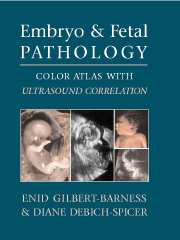Book contents
- Frontmatter
- Contents
- Foreword by John M. Opitz
- Preface
- Acknowledgments
- 1 The Human Embryo and Embryonic Growth Disorganization
- 2 Late Fetal Death, Stillbirth, and Neonatal Death
- 3 Fetal Autopsy
- 4 Ultrasound of Embryo and Fetus: General Principles
- 5 Abnormalities of Placenta
- 6 Chromosomal Abnormalities in the Embryo and Fetus
- 7 Terminology of Errors of Morphogenesis
- 8 Malformation Syndromes
- 9 Dysplasias
- 10 Disruptions and Amnion Rupture Sequence
- 11 Intrauterine Growth Retardation
- 12 Fetal Hydrops and Cystic Hygroma
- 13 Central Nervous System Defects
- 14 Craniofacial Defects
- 15 Skeletal Abnormalities
- 16 Cardiovascular System Defects
- 17 Respiratory System
- 18 Gastrointestinal Tract and Liver
- 19 Genito-Urinary System
- 20 Congenital Tumors
- 21 Fetal and Neonatal Skin Disorders
- 22 Intrauterine Infection
- 23 Multiple Gestations and Conjoined Twins
- 24 Metabolic Diseases
- Appendices
- Index
21 - Fetal and Neonatal Skin Disorders
Published online by Cambridge University Press: 23 February 2010
- Frontmatter
- Contents
- Foreword by John M. Opitz
- Preface
- Acknowledgments
- 1 The Human Embryo and Embryonic Growth Disorganization
- 2 Late Fetal Death, Stillbirth, and Neonatal Death
- 3 Fetal Autopsy
- 4 Ultrasound of Embryo and Fetus: General Principles
- 5 Abnormalities of Placenta
- 6 Chromosomal Abnormalities in the Embryo and Fetus
- 7 Terminology of Errors of Morphogenesis
- 8 Malformation Syndromes
- 9 Dysplasias
- 10 Disruptions and Amnion Rupture Sequence
- 11 Intrauterine Growth Retardation
- 12 Fetal Hydrops and Cystic Hygroma
- 13 Central Nervous System Defects
- 14 Craniofacial Defects
- 15 Skeletal Abnormalities
- 16 Cardiovascular System Defects
- 17 Respiratory System
- 18 Gastrointestinal Tract and Liver
- 19 Genito-Urinary System
- 20 Congenital Tumors
- 21 Fetal and Neonatal Skin Disorders
- 22 Intrauterine Infection
- 23 Multiple Gestations and Conjoined Twins
- 24 Metabolic Diseases
- Appendices
- Index
Summary
SEBORRHEA AND DRY DESQUAMATION
Miliaria
Secretion of sweat normally exudes from the glands but occasionally collects in the gland ducts, distending them so that they are visible at birth as discrete pinpoint elevations known as milia crystalline (Figure 21.1). They usually disappears during the first week of life. They are most often visible on the forehead, cheeks, and sides of the nose. Microscopically a keratinous plug and an intra- or subcorneal vesicle communicates with the underlying sweat duct, sometimes with a mild inflammatory infiltrate. When the process is deeper, prickly heat (miliaria rubra) occurs.
Milia are pearly yellow 1 to 3-mm papules on the face, chin, and forehead of 50% of newborns. Occasionally they erupt on the trunk and extremities. Although milia usually resolve without treatment during the first month of life, they may persist for several months. Microscopically they are miniature epidermal inclusion cysts, which arise from the pilosebaceous apparatus of vellus hairs.
Seborrheic Dermatitis
The scalp is most often affected in the newborn and is often associated with incomplete removal of the vernix caseosa. The lesions are poorly defined, yellowred salmon-colored patches covered by waxy, greasy, easily removed scales.
Acanthosis, edema, and occasional perivascular infiltration of leukocytes are present as well as spongiosis of the basal layer seen microscopically (Figure 21.2).
- Type
- Chapter
- Information
- Embryo and Fetal PathologyColor Atlas with Ultrasound Correlation, pp. 579 - 600Publisher: Cambridge University PressPrint publication year: 2004



